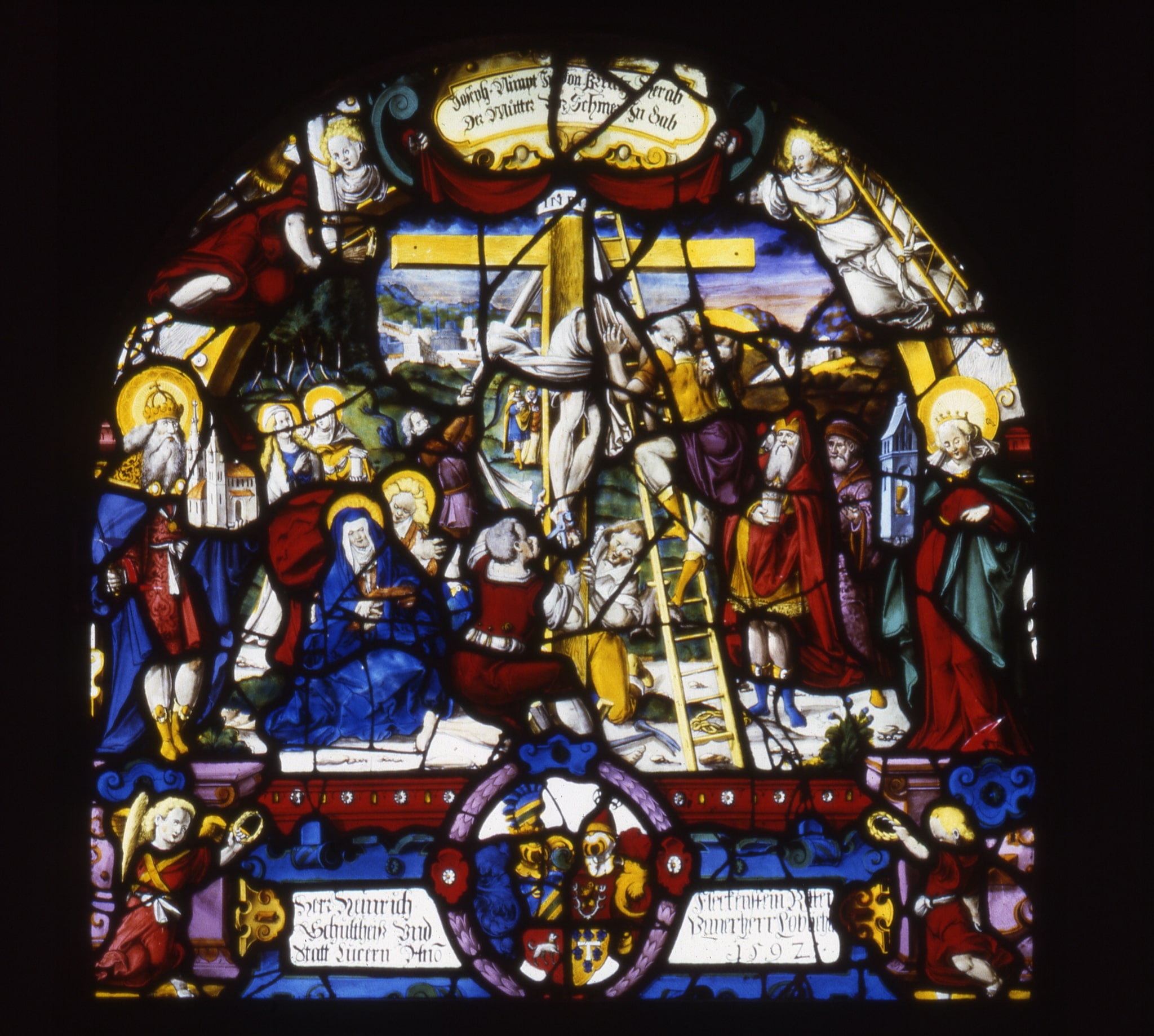Christ is being taken down from the cross, a scene played out against a broad landscape with mountains in the distance The scene is densely populated. In the center, a muscular young man climbs a ladder and receives the body of Christ across his shoulder. The descent is aided by a cloth sling held tightly by a man behind the cross. Another young man uses pliers to pull a large nail from Christ’s still bleeding feet. The Virgin Mary is seated on the ground to the left with St. John, beardless and with billowing blond hair, behind her. Mary Magdalene, identified by her long flowing hair, stands behind them with one of the other Three Marys who would later anoint Christ’s tomb (Mark 16). Thus, we see the projected meaning of the unguent jar that the second woman carries. To the right are the older men, as described in the Gospel of John (19:38-42). Coming first, with the unguent jar, is Joseph of Arimathea, who offered his own tomb to receive Christ’s body. Behind him is Nicodemus, a prominent member of the Jewish community who had earlier visited Christ in the secrecy of night (John 3: 1-21). The scene is evening, distinguished by the russet tone of the sky. In the distance is the city of Jerusalem. In the middle ground, two men to the left of the cross, appear in conversation, possibly a reference to the followers who would see the resurrected Christ on the Road to Emmaus. The Emperor Henry II is on the left and St. Barbara is on the right. An inscription panel supported by angels holding the instruments of the Passion culminates the arch. Below, a coat of arms sits in the center of the dedicatory inscription flanked by angels holding victory wreaths.
11H(HENRY) · the Holy Roman emperor Henry II of Bamberg; possible attributes: crown, lily, model of church, orb, sceptre, sword
11HH(BARBARA) · the virgin martyr Barbara; possible attributes: book, cannon(ball), crown, cross, chalice with wafer, Dioscuros (her father), peacock feather, sword, torches, mason's tools, tower
46A122(FLECKENSTEIN) · armorial bearing, heraldry (FLECKENSTEIN)
73D71 · descent from the cross: Christ is taken down from the cross, usually by Nicodemus and Joseph of Arimathaea who are standing on the ladders (both arms of Christ detached)
Arms of Fleckenstein, Heinrich: Quarterly; 1 per bend sinister in chief azur an Imperial orb or in base bendy of four vert and or; 2 gules a pair of antlers argent and thereon a lion rampant or (Unidentified); 3 and 4 replaced by stopgaps; crest: (LEFT) on a barred helm to sinister a ducal coronet and therefrom a demi-vol charged as the base arms; (RIGHT) on a barred helm to dexter a cap gules banded or; mantling dexter and sinister of the colors.
Joseph Nimpt Jn Von Kreutz Herab/ Der Můtter […]r Schmer[.] In Gab (above the scene. Joseph takes Jesus down from the Cross; the mother is given [over] to sorrow)
Herr Heinrich Fleckenstein Ritter/ Schulttheiβ vnd Banerherr Loblich / Statt Lucern Anō 1592 (below scene. Mr. Heinrich Fleckenstein, knight, mayor and military commander of the praiseworthy city of Lucerne, in the year 1592. Bannerherr, literally Standard Bearer, can be translated as the rank of colonel).
none
